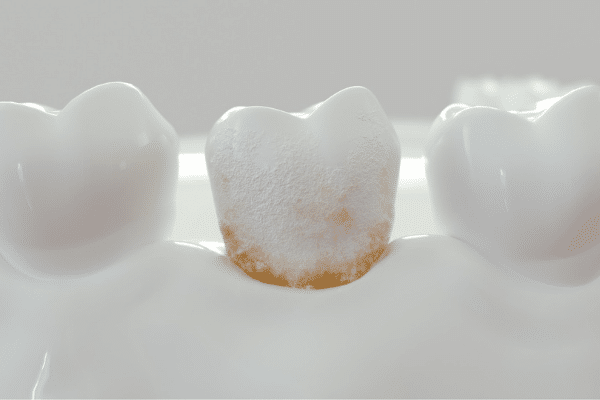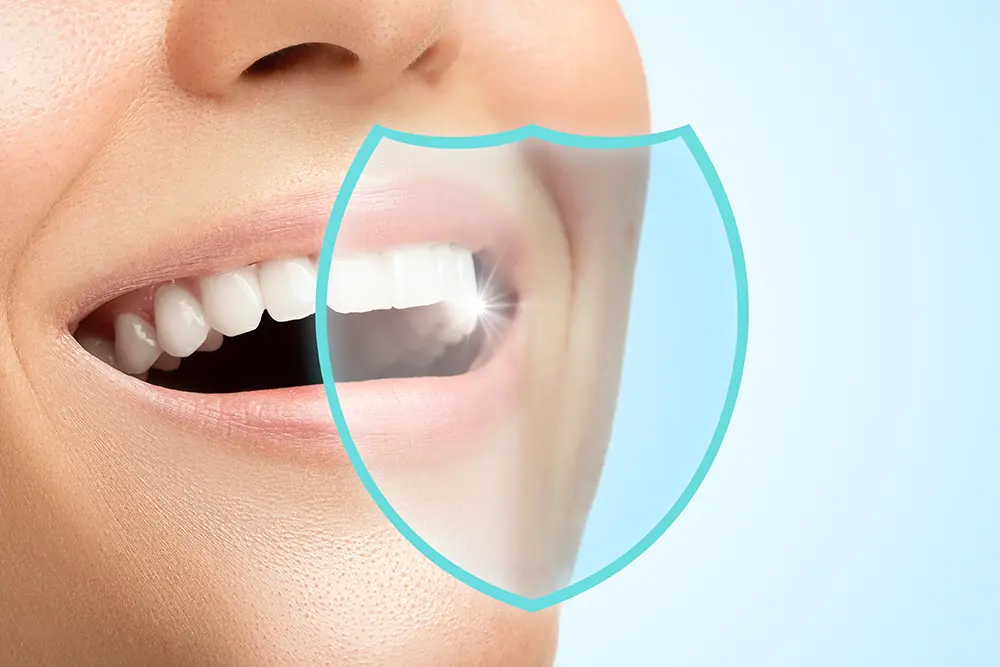Dental plaque is an adherent accumulation of bacteria that forms on your teeth soon after you have cleaned them; it is that curd-like material that you can scrape off your teeth using a fingernail, especially after consuming foods high in sugar content. The build-up of dental plaque increases proportionately with time unless it is mechanically removed through thorough brushing and flossing.
The formation of dental plaque is influenced by saliva, as well as the foods we consume; a diet high in sugar and carbohydrates tend to increase the rate of plaque build-up. In smokers or patients with dry mouth, where the salivary clearance is lower, dental plaque build-up may also be greater. Typically, dental plaque starts forming first from where the teeth and gums meet. The build-up of dental plaque can trap stains, and what started as a relatively colourless deposit can start to take on a yellow, or even orange tinge.
Long term accumulation of dental plaque will lead to diseases like dental decay, gum inflammation (gingivitis), and gum disease (periodontitis), and can result in a severe tooth or gum destruction necessitating costly dental treatment to remedy the damage, or in severe cases, loss of teeth and dental implants.
What is tartar and how it differs from plaque?
Tartar is the calcified form of dental plaque, and when left in situ for long periods of time, can also lead to dental diseases, exactly like dental plaque. Tartar usually forms in areas where dental plaque has not been satisfactorily removed for a protracted period of time; it is also more likely to form in areas where the salivary glands drain into the mouth, like behind the lower front teeth, and on the cheek-side of the upper back teeth. Tartar is usually more noticeable to the patient, as it can feel quite rough on the surface, and can take up stains and appear yellow, orange, brown, green, or even black.
How can you tell if you have plaque or tartar?
Often plaque and tartar may not be very visible to the untrained eye, and most people only notice these deposits when the plaque or tartar picks up stains over time. The dentist can use a special solution made from food dye to disclose these deposits so that they are visible to the patient when they go for routine dental cleaning. Usage of disclosing solutions can help to visually highlight areas in the mouth where there is a greater build-up of plaque or tartar, and also assist the dentist to demonstrate which oral hygiene tools (e.g. toothbrush, floss, interdental brush, etc) can effectively remove these deposits in specific areas.
Beyond the dental office, consumers can purchase special toothpaste that has the ability to disclose plaque and tartar; this will allow better recognition of these deposits in one’s mouth, and hopefully, translate to more effective removal of the deposits during daily mechanical oral hygiene.
Can dental plaque cause bad breath?
Yes, it can. When there is a significant build-up of dental plaque on your teeth, gums and tongue over a period of time, it can start to smell and result in bad breath. The intensity of bad breath can be influenced by smoking and is usually worse if the person has a dry mouth.
Brushing your teeth twice a day and flossing regularly, as well as brushing your tongue, will reduce the bacterial plaque load in the mouth, and hence mitigate the issue of bad breath.
How can plaque or tartar be removed?
Dental plaque can be effectively removed with self-performed daily mechanical oral hygiene procedures, including brushing of teeth, flossing, and use of other oral hygiene aids (e.g. interdental brush, tongue cleaner, etc), as long as it is done appropriately. A visit to the dental office to have your teeth cleaned and polished can reliably remove adherent dental plaque, especially in difficult to reach areas.
Tartar, on the other hand, cannot be removed simply with the use of home hygiene products or your daily teeth cleaning regimen; it can only be removed by a dental professional via scaling of the teeth. Consumers should be cautious about using devices bought over the internet, or over-the-counter (OTC) products that claim to be able to remove tartar; incorrect and unsupervised use of these devices and products can sometimes lead to irreversible damage of the gums and teeth.
Tips to prevent or reduce the build-up of dental plaque and tartar
- Brush and floss regularly
- Brush your tongue
- Reducing carbohydrates and sugars in your diet
- Increase water intake
- Reduce smoking
- Schedule regular dental visits for professional examination and cleaning
Some FAQs about dental plaque and tartar
Dental plaque is a collection of bacteria.
Tartar is calcified and hardened plaque.
Bacteria in dental plaque feeds off your sugar intake and use it to produce acid; these acids are the cause of dental decay.
The longer the dental plaque sits on your teeth and gums, the more pathogenic the collection of bacteria becomes; this increases the risk of dental decay and gum disease.
The most effective method to remove dental plaque is through regular mechanical oral hygiene (e.g. brushing, flossing, interdental cleaning, etc.)
Some mouthwashes can help reduce the speed at which plaque and tartar builds up, but they do not replace the removal of plaque via daily mechanical oral hygiene.




